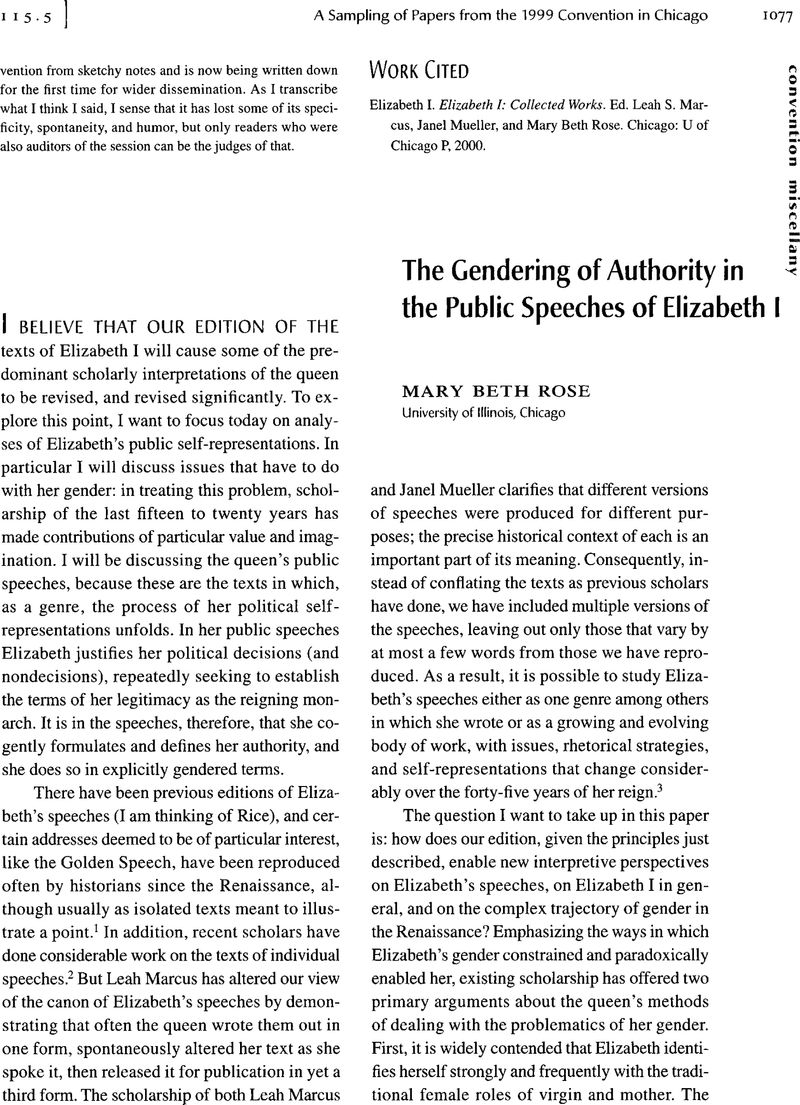Article contents
The Gendering of Authority in the Public Speeches of Elizabeth I
Published online by Cambridge University Press: 23 October 2020
Abstract

- Type
- Other
- Information
- Copyright
- Copyright © Modern Language Association of America, 2000
References
Notes
1 See George P. Rice, Jr, ed., The Public Speaking of Queen Elizabeth: Selections from Her Official Addresses (New York: Columbia UP, 1951); John Neale, Queen Elizabeth I and Her Parliaments, 1584–1581 (London: Cape, 1953), and Queen Elizabeth I and Her Parliaments, 15841601 (London: Cape, 1957). For a recent biography based on Elizabeth's utterances, see Maria Perry, The Word of a Prince: A Life of Elizabeth I (Woodbridge, Eng.: Boydell, 1990).
2 See, for example, Perry; Allison Heisch, “Queen Elizabeth I: Parliamentary Rhetoric and the Exercise of Power,” Signs 1 (1975): 31–55; Louis Montrose, “The Elizabethan Subject and the Spenserian Text,” Literary Theory/Renaissance Texts, ed. Patricia Parker and David Quint (Baltimore: Johns Hopkins UP, 1986) 303–40; and John N. King, “Queen Elizabeth I: Representations of the Virgin Queen,” Renaissance Quarterly 43 (1990) 30–74.
3 Leah S. Marcus, Janel Mueller, and Mary Beth Rose, eds., Elizabeth I: Collected Works (Chicago: U of Chicago P, 2000). See the preface, in which the rationale for our editorial decisions is explained in detail. All quotations from Elizabeth's speeches come from our edition and will be documented in the text by page numbers.
4 Frances Yates, Astraea: The Imperial Theme in the Sixteenth Century (London: Routledge, 1975); Roy Strong, The Cult of Elizabeth: Elizabethan Portraiture and Pageantry (Wallop, Eng.: Thames, 1977); Philippa Berry, Of Chastity and Power: Elizabethan Literature and the Unmarried Queen (New York: Routledge, 1989); Helen Hackett, Virgin Mother, Maiden Queen: Elizabeth I and the Cult of the Virgin Mary (New York: St. Martin's, 1995); Heisch 32; Montrose 310; Susan Frye, Elizabeth I: The Competition for Representation (New York: Oxford UP, 1993) 54. See also Carole Levin, The Heart and Stomach of a King: Elizabeth I and the Politics of Sex and Power (Philadelphia: U of Pennsylvania P, 1994); Marie Axton, The Queen's Two Bodies: Drama and the Elizabethan Succession (London: Royal Hist. Soc, 1977); and King, whose analysis of different versions of Elizabeth's 1559 speech to Parliament about her marriage and succession provides a good corrective to the arguments about the queen's focus on her own virginity.
5 See, for an exception, her French prayer, in Marcus, Mueller, and Rose 314, where she thanks God for “the honor of being mother and nurse of Thy dear children.”
6 Mary Beth Rose, “Where Are the Mothers in Shakespeare? Options for Gender Representation in the English Renaissance,” Shakespeare Quarterly 42 (1991): 291–314.
7 Variations of this argument are made in, among other places, the sources listed in n4.
8 Constance Jordan, “Woman's Rule in Sixteenth-Century British Political Thought,” Renaissance Quarterly 40 (1987): 421–51, and Renaissance Feminism: Literary Texts and Political Models (Ithaca: Cornell UP, 1990). See also Maureen Quilligan, The Allegory of Female Authority: Christine de Pizan's Cité des Dames (Ithaca: Cornell UP, 1991).
9 See Anne L. Prescott, “The Pearl of the Valois and Elizabeth I: Marguerite de Navarre's Miroir and Tudor England,” Silent but for the Word: Tudor Women as Patrons, Translators, and Writers of Religious Works, ed. Margaret Hannay (Kent: Kent State UP, 1985) 61–76.
- 5
- Cited by


